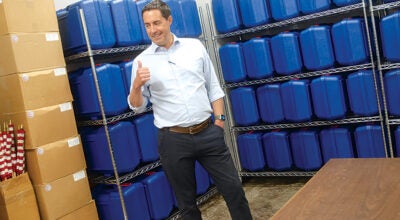The Misson: Keeping students fit
Published 11:10 pm Saturday, October 3, 2009
Next week Fairland West Elementary has slated a “Fairland Fitness Fun Friday” to kick off the school’s participation this year in St. Mary’s Medical Center HEART Program. This program comes from the acronym of Helping Educators Attack Cardiovascular Risk Factors.
The goal Fairland wants to attack is making sure their young students know all they can about staying healthy now and in their future. Three years ago the school, with parental permission, brought in a team of health professionals to screen the students for obesity, high blood pressure and high cholesterol.
The results were not all that the school wanted to hear so educators accepted the challenge and developed a variety of programs that would teach the youngsters the importance of exercise and good nutrition.
On Friday Nathan Speed, Fairland physical education and health instructor, along with teachers and parent volunteers, will take students through their exercise paces in fun and information-filled activities such as jump rope, hula hoop, a tug of war and an obstacle course.
“Many of our students participate in sports such as soccer, football, basketball, gymnastics and cheerleading,” Teresa Johnson, school principal, said. “Every child needs to exercise regularly. Our goal is to provide a safe and caring environment to help our students develop to the best of their mental and physical ability. Our school is fortunate to have the support of the parents in these endeavors.”
Fairland’s situation is far from unique. Poor exercise and eating habits have turned the weight issue for young people in this country into an epidemic.
One out of three American children is deemed overweight or obese. The culprits are multiple: too much high caloric and fat laden fast food; too much time in front of television sets and computers; too few family meals with low-fat meats, vegetables and fruits; and too little time doing basic calorie-consuming activities.
And Fairland is not the only school district that is squaring off with this health issue.
Throughout the public and parochial school districts in Lawrence County are programs, clubs and one-on-ones to make their children heart and body healthy now and throughout their adulthood.
Last year Chesapeake Middle School instituted a Walking Club, where students were encouraged to stay after school to walk, either on the outdoor track or inside the school building.
“We had members from all four grade levels,” Cecili Nida, teacher at Chesapeake Middle, said. “Anything I do at the middle school is to raise awareness of their lifestyle. How much more time they are sitting in front of a screen and not doing. The concept is to get them to move more.”
Chesapeake is also a partner with St. Mary’s in the HEART program, where screenings are done at the first of a school year and then rechecked at the end of the year.
“So kids can see drastic changes,” Nida said. “If St. Mary’s sees it is necessary they will contact the parents directly. It is all confidential. We don’t see the results. … Our main desire at the middle schools is to make them aware. … Most of them are fine and dandy and get plenty of exercise, but there is a percentage who doesn’t understand.”
Five years ago, three students at Marshall University’s Medical School wanted to get the word out about childhood obesity, so they collected donations from the community to fund health fairs at elementary schools in Cabell County. The fairs were so successful, the med school applied for funding and created the “Let’s Get Moving Program.”
Now the program is two-pronged: health fairs at schools and intervention programs for young children who are overweight or obese.
At the fairs children are screened for weight issues at activity, nutrition and vital statistics stations.
“We send the data to the parents so they are aware,” Kayleigh Dye, coordinator of “Let’s Get Moving,” said.
The intervention program is open to children between the ages of 7 to 12 years old who have a body mass index measurement or BMI of 85 percentile or above.
BMI is calculated by comparing a child’s weight to his or her height.
“How much you weigh as to how tall you are,” Dye. “A percentile of 85 to 95 is overweight; 95 and above is obese.”
Children in the year-long intervention receive four free visits to a physician, a free membership to Huntington’s YMCA, opportunity to learn proper exercise with MU med students and nutritional advice.
“It is really important that they develop habits early in life,” Dye said. “They look to teachers and parents and community leaders as role models. These are things that will stick to them forever. When you develop habits in your child like enrolling the child in soccer or walking with them in the park, they are more likely to exercise when they are older. They know it is something they had fun doing.”
Cindy Brown is the nurse for Ironton Catholic Schools and approaches teaching the value of health lessons on two fronts. She works with King’s Daughters Medical Center in Ashland, Ky., on bringing in educational programs.
“They come talk about nutrition and how to have a healthy heart,” Brown said. “They have a heart challenge the kids like where they teach kids how to exercise.”
But assemblies are just one way Brown encourages healthy habits in the students; the individual approach is also effective, she said.
“A lot of time when I go into the lunchroom, I just one-on-one talk to them about what they are eating,” she said. “If mom packs cookies, they will eat the cookies first. I will talk to the little kids that now we have to eat our good food first. … What they do now carries through to their whole lives. It is so important for them to get good examples from their peers.”




